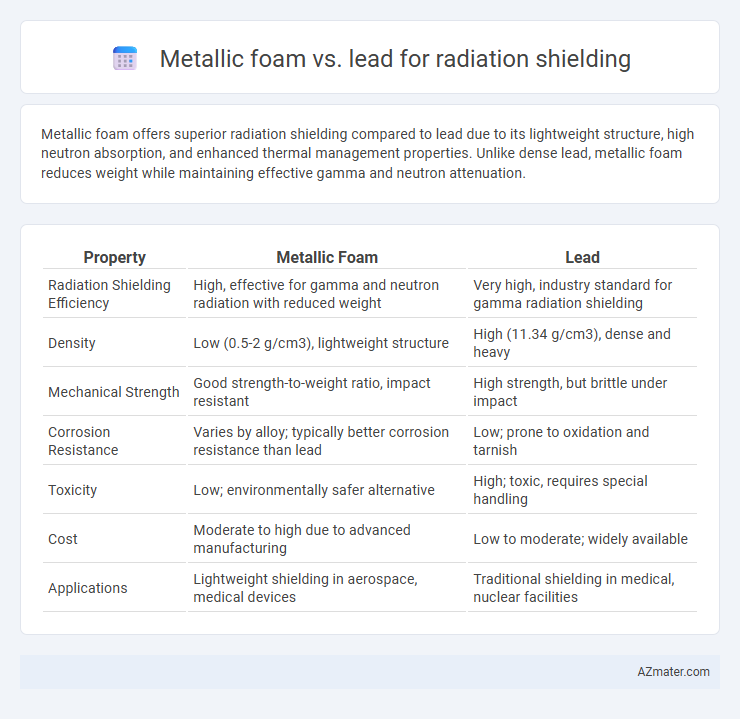Metallic foam offers superior radiation shielding compared to lead due to its lightweight structure, high neutron absorption, and enhanced thermal management properties. Unlike dense lead, metallic foam reduces weight while maintaining effective gamma and neutron attenuation.
Table of Comparison
| Property | Metallic Foam | Lead |
|---|---|---|
| Radiation Shielding Efficiency | High, effective for gamma and neutron radiation with reduced weight | Very high, industry standard for gamma radiation shielding |
| Density | Low (0.5-2 g/cm3), lightweight structure | High (11.34 g/cm3), dense and heavy |
| Mechanical Strength | Good strength-to-weight ratio, impact resistant | High strength, but brittle under impact |
| Corrosion Resistance | Varies by alloy; typically better corrosion resistance than lead | Low; prone to oxidation and tarnish |
| Toxicity | Low; environmentally safer alternative | High; toxic, requires special handling |
| Cost | Moderate to high due to advanced manufacturing | Low to moderate; widely available |
| Applications | Lightweight shielding in aerospace, medical devices | Traditional shielding in medical, nuclear facilities |
Introduction to Radiation Shielding Materials
Metallic foams offer a lightweight alternative to traditional lead for radiation shielding, combining structural strength with effective attenuation properties. Unlike solid lead, metallic foams allow for reduced weight without significantly compromising shielding efficiency, making them ideal for aerospace and medical applications. Their porous structure enables customized density and thickness to optimize protection against gamma rays and X-rays.
Overview of Metallic Foam as a Shielding Material
Metallic foam offers a lightweight, high-strength alternative for radiation shielding, combining low density with excellent neutron and gamma radiation attenuation properties. Its porous structure enhances energy absorption and thermal management compared to traditional solid metals like lead. This unique combination makes metallic foam an effective choice for aerospace and medical applications where weight reduction and efficient radiation protection are critical.
Traditional Use of Lead in Radiation Shielding
Lead has been the traditional material of choice for radiation shielding due to its high density and atomic number, which provide excellent attenuation of gamma rays and X-rays. Its malleability allows for easy fabrication into various thicknesses and shapes, making it versatile for medical, nuclear, and industrial applications. However, lead's toxicity and environmental impact have prompted the exploration of alternatives like metallic foam, which offers comparable shielding capabilities with reduced weight and enhanced structural properties.
Physical Properties: Metallic Foam vs Lead
Metallic foam exhibits significantly lower density and weight compared to traditional lead, offering enhanced ease of handling and installation in radiation shielding applications. Its porous structure provides a combination of high strength-to-weight ratio and effective energy absorption, which can be advantageous for attenuating certain radiation types. In contrast, lead's high density makes it exceptionally effective for gamma and X-ray attenuation, though its weight and toxicity present handling and environmental challenges.
Shielding Effectiveness and Attenuation Comparison
Metallic foam offers superior radiation shielding effectiveness compared to lead due to its high hydrogen content and porous structure, which enhances neutron attenuation and reduces secondary radiation. While lead excels in gamma ray attenuation because of its high density and atomic number, metallic foam provides a balanced attenuation across neutron and gamma radiation with significantly reduced weight. The attenuation performance of metallic foam can be tailored by varying its composition and porosity, resulting in versatile shielding solutions that often surpass lead in multi-radiation environments.
Weight and Structural Advantages
Metallic foam offers significant weight reduction compared to lead, making it advantageous for radiation shielding in applications where minimizing mass is critical, such as aerospace and mobile medical devices. The porous structure of metallic foam provides superior mechanical strength and energy absorption, enhancing structural support while maintaining effective radiation attenuation. Unlike dense lead, metallic foam combines lightweight properties with durability, reducing handling risks and improving overall design flexibility.
Environmental and Health Impacts
Metallic foam offers a sustainable alternative to lead for radiation shielding due to its reduced toxicity and recyclability, minimizing environmental contamination from heavy metals. Lead exposure is linked to severe health issues such as neurological damage and kidney disease, posing risks to workers and communities during manufacturing and disposal. Employing metallic foam decreases hazardous waste generation and promotes safer handling, aligning with stricter environmental regulations and advancing public health protection.
Cost Analysis and Economic Feasibility
Metallic foam offers a cost-efficient alternative to lead for radiation shielding due to its lightweight nature and lower material costs, reducing transportation and installation expenses. Despite lead's higher density providing superior attenuation per unit thickness, metallic foam's structural benefits and recyclability contribute to long-term economic feasibility. The initial investment in metallic foam technology often results in reduced maintenance and disposal costs, making it a viable option for budget-conscious radiation shielding projects.
Applications in Medical and Industrial Settings
Metallic foam offers superior radiation shielding efficiency compared to lead, particularly in medical and industrial settings, due to its lightweight structure combined with high neutron and gamma ray attenuation. Its use in protective barriers and medical imaging rooms enhances safety without compromising structural integrity or increasing weight, which is crucial for portable and modular shielding solutions. Industrial applications benefit from metallic foam's corrosion resistance and thermal stability, making it ideal for environments exposed to harsh chemicals and fluctuating temperatures.
Future Trends and Innovations in Radiation Shielding
Metallic foam offers superior radiation attenuation with reduced weight compared to lead, driving a shift towards lightweight, high-performance shielding materials. Ongoing innovations include the integration of nanomaterials and hybrid composites to enhance neutron and gamma radiation protection while maintaining structural integrity. Future trends emphasize sustainable, non-toxic alternatives to lead, leveraging additive manufacturing for customizable, application-specific radiation shields in aerospace and medical industries.

Infographic: Metallic foam vs Lead for Radiation shielding
 azmater.com
azmater.com